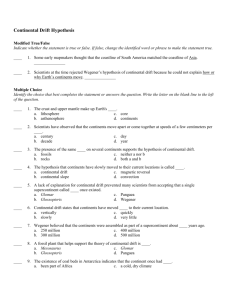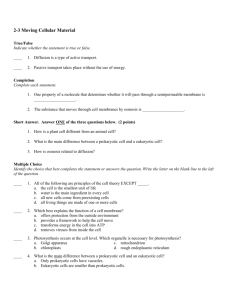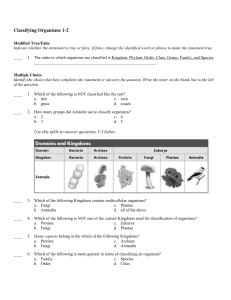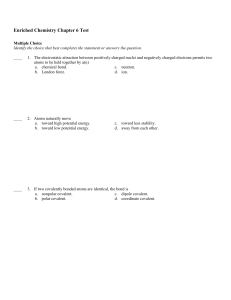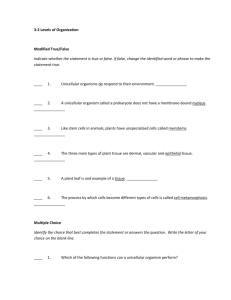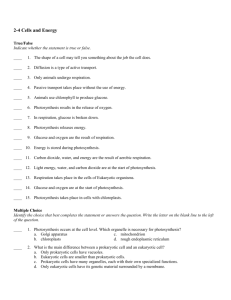Sea Floor Spreading 7-2
advertisement
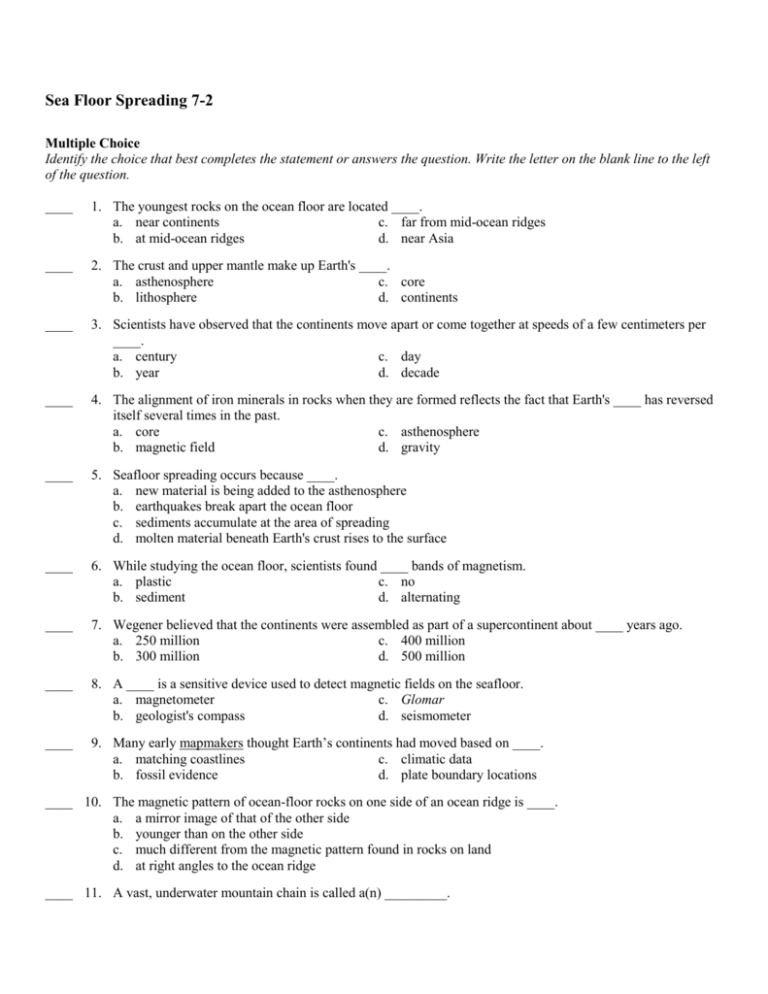
Sea Floor Spreading 7-2 Multiple Choice Identify the choice that best completes the statement or answers the question. Write the letter on the blank line to the left of the question. ____ 1. The youngest rocks on the ocean floor are located ____. a. near continents c. far from mid-ocean ridges b. at mid-ocean ridges d. near Asia ____ 2. The crust and upper mantle make up Earth's ____. a. asthenosphere c. core b. lithosphere d. continents ____ 3. Scientists have observed that the continents move apart or come together at speeds of a few centimeters per ____. a. century c. day b. year d. decade ____ 4. The alignment of iron minerals in rocks when they are formed reflects the fact that Earth's ____ has reversed itself several times in the past. a. core c. asthenosphere b. magnetic field d. gravity ____ 5. Seafloor spreading occurs because ____. a. new material is being added to the asthenosphere b. earthquakes break apart the ocean floor c. sediments accumulate at the area of spreading d. molten material beneath Earth's crust rises to the surface ____ 6. While studying the ocean floor, scientists found ____ bands of magnetism. a. plastic c. no b. sediment d. alternating ____ 7. Wegener believed that the continents were assembled as part of a supercontinent about ____ years ago. a. 250 million c. 400 million b. 300 million d. 500 million ____ 8. A ____ is a sensitive device used to detect magnetic fields on the seafloor. a. magnetometer c. Glomar b. geologist's compass d. seismometer ____ 9. Many early mapmakers thought Earth’s continents had moved based on ____. a. matching coastlines c. climatic data b. fossil evidence d. plate boundary locations ____ 10. The magnetic pattern of ocean-floor rocks on one side of an ocean ridge is ____. a. a mirror image of that of the other side b. younger than on the other side c. much different from the magnetic pattern found in rocks on land d. at right angles to the ocean ridge ____ 11. A vast, underwater mountain chain is called a(n) _________. a. ocean ridge b. oceanic crust c. deep-sea trench d. ocean floor sediment Completion Complete each statement. 1. Wegener’s hypothesis of _________________________ stated that Earth’s continents had once been joined as a single landmass. 2. The theory of _________________________ explains how new crust is created at mid-ocean ridges. 3. A change in Earth’s magnetic field is called a(n) _________________________. Matching Match each process of seafloor spreading A, B, or C with its description below. Two points each. ____ 1. Hot lava fills the gap that forms at the ridge. ____ 2. The lava hardens, to form a small amount of ocean floor. ____ 3. Hot magma is forced toward crust along an ocean ridge. Sea Floor Spreading 7-2 Answer Section MULTIPLE CHOICE 1. ANS: B The closer the crust is to a mid-ocean ridge, the younger the oceanic crust is. PTS: 1 DIF: Bloom's Level 1 | DOK 1-LOW REF: To review this topic refer to Plate Tectonics: Lesson 2 OBJ: 7-3 STA: 5.4.6.B.1 2. ANS: B The cold and rigid outermost rock layer is called the lithosphere. It is made up of the crust and the solid, uppermost mantle. PTS: 1 DIF: Bloom's Level 1 | DOK 1-LOW REF: To review this topic refer to Plate Tectonics: Lesson 3 OBJ: 7-5 STA: 5.4.6.B.1 | 5.4.6.D.1 3. ANS: B Continents move apart or come together at speeds of a few centimeters per year. PTS: 1 DIF: Bloom's Level 1 | DOK 1-LOW REF: To review this topic refer to Plate Tectonics: Lesson 3 OBJ: 7-6 STA: 5.4.8.D.2 4. ANS: B Iron-rich minerals in cooling lava align with Earth’s magnetic field. When Earth’s magnetic field changes direction, minerals in fresh lava record a new magnetic signature. PTS: 1 DIF: Bloom's Level 1 | DOK 1-LOW REF: To review this topic refer to Plate Tectonics: Lesson 2 OBJ: 7-4 STA: 5.4.6.D.3 5. ANS: D When the seafloor spreads, the mantle below melts and forms magma. Because magma is less dense than solid mantle material, it rises through cracks in the crust along the midocean ridge. PTS: 1 DIF: Bloom's Level 1 | DOK 1-LOW REF: To review this topic refer to Plate Tectonics: Lesson 2 OBJ: 7-3 STA: 5.4.6.C.2 | 5.4.6.C.3 6. ANS: D Scientists have discovered parallel magnetic stripes on either side of the midocean ridge. Each pair of stripes has a similar composition, age, and magnetic character. PTS: 1 DIF: Bloom's Level 1 | DOK 1-LOW REF: To review this topic refer to Plate Tectonics: Lesson 2 OBJ: 7-4 STA: 5.4.6.D.3 | 5.4.8.D.3 7. ANS: A When Wegener pieced Pangaea together, he proposed that South America, Africa, India, and Australia were located closer to the South Pole 250 million years ago. PTS: 1 DIF: Bloom's Level 1 | DOK 1-LOW REF: To review this topic refer to Plate Tectonics: Lesson 1 OBJ: 7-2 STA: 5.4.8.D.2 8. ANS: A Scientists studied magnetic minerals in rocks from the seafloor. They used a magnetometer to measure and record the magnetic signature of these rocks. PTS: 1 DIF: Bloom's Level 1 | DOK 1-LOW REF: To review this topic refer to Plate Tectonics: Lesson 2 OBJ: 7-4 STA: 5.4.6.D.3 | 5.4.8.D.3 9. ANS: A Hundreds of years ago mapmakers noticed this jigsaw-puzzle pattern as they made the first maps of the continents. PTS: 1 DIF: Bloom's Level 2 | DOK 1-LOW REF: To review this topic refer to Plate Tectonics: Lesson 1 OBJ: 7-1 STA: 5.4.6.B.3 | 5.4.6.D.2 10. ANS: A Scientists have discovered parallel magnetic stripes on either side of the midocean ridge. PTS: 1 DIF: Bloom's Level 2 | DOK 1-LOW REF: To review this topic refer to Plate Tectonics: Lesson 2 OBJ: 7-4 STA: 5.4.8.D.3 11. ANS: A The mountain ranges in the middle of the oceans are called mid-ocean ridges. PTS: 1 DIF: Bloom's Level 2 | DOK 1-LOW REF: To review this topic refer to Plate Tectonics: Lesson 2 STA: 5.4.6.D.1 | 5.4.8.D.2 OBJ: 7-4 COMPLETION 1. ANS: continental drift PTS: REF: STA: 2. ANS: 1 DIF: Bloom's Level 1 | DOK 1-LOW To review this topic refer to Plate Tectonics: Lesson 1 5.4.6.D.1 | 5.4.8.D.2 seafloor spreading PTS: REF: STA: 3. ANS: 1 DIF: Bloom's Level 1 | DOK 1-LOW To review this topic refer to Plate Tectonics: Lesson 2 5.4.6.C.3 | 5.4.6.D.1 | 5.4.8.D.2 magnetic reversal PTS: 1 DIF: Bloom's Level 1 | DOK 1-LOW REF: To review this topic refer to Plate Tectonics: Lesson 2 STA: 5.4.6.C.3 | 5.4.6.D.1 | 5.4.8.D.2 OBJ: 7-1 OBJ: 7-3 OBJ: 7-4 MATCHING 1. ANS: REF: STA: 2. ANS: REF: STA: 3. ANS: REF: STA: B PTS: 1 DIF: Bloom's Level 2 | DOK 1-LOW To review this topic refer to Plate Tectonics: Lesson 2 OBJ: 7-3 5.4.6.C.3 | 5.4.6.D.1 | 5.4.8.D.2 C PTS: 1 DIF: Bloom's Level 2 | DOK 1-LOW To review this topic refer to Plate Tectonics: Lesson 2 OBJ: 7-3 5.4.6.C.3 | 5.4.6.D.1 | 5.4.8.D.2 A PTS: 1 DIF: Bloom's Level 2 | DOK 1-LOW To review this topic refer to Plate Tectonics: Lesson 2 OBJ: 7-3 5.4.6.C.3 | 5.4.6.D.1 | 5.4.8.D.2
